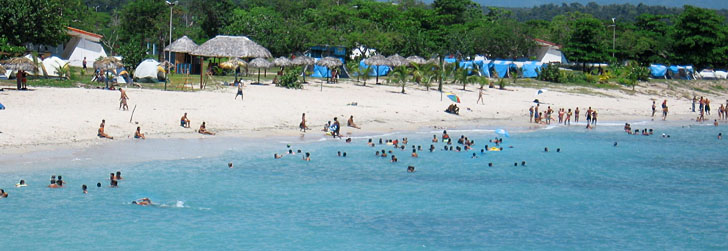In general, most people believe that the indigenous people found by Christopher Columbus upon arrival in Cuba were the Siboneyes, so the word siboney has become something of a synonym for “Cuban Indian.”
And this is the first mistake that we must discard, because the most important aborigines of Cuba were not siboneyes, nor were these the ones who surprised the admiral for his virtues and mortified Diego Velázquez for his resistance under Hatuey, coming from the island of Quisqueya, and then under the heroic Guamá, a Taino leader among the first rebels who confronted the Spanish colonizers, fighting for ten years in the mountains of eastern Cuba.
The Cuban aborigines are the result of diverse migratory waves that arrived in Cuba from different places of the continental America and have been denominated in three types: guanatabeyes, siboneyes and taínos.
The Guanatabeyes, Siboneyes and Tainos were the first peoples that inhabited Cuba, according to studies, coming from South America between 3500 and 2000 BC. the guanatabeyes lived in Cuevas in the west and the Siboneyes lived in the eastern part of the island. The two very primitive tribes were farmers and fishermen.
It is also a great mistake to believe that the largest Antillean archipelago was first discovered by Columbus on October 27, 1492. This was a petulance of the Spaniards. Cuba had already been found several times by other men from previous centuries, from other lands, although not from Europe, that is how their Indians came to Cuba.
The arrival of the Asian man to the lands of America through the Bering Strait has been proven. We must also admit the possibility of a relationship between the cultures of South American natives, from which some of the Indo-Antillean groups have come. And centuries later, it was the arrival of the ones from Europe, specifically of Spain.
ABORIGENES SIBONEYES NO DEBEN SER SINONIMOS DE “INDIO CUBANO”.
Por los general, la mayoría de las personas creen que lo indígenas hallados por Cristóbal Colón a su llegada a Cuba era los siboneyes, por lo que la palabra siboney se ha convertido en algo así como sinónimo de “indio cubano”.
Y este es el primer error que debemos desechar, porque los más importantes aborígenes de Cuba no eran siboneyes, ni fueron estos los que sorprendieron al almirante por sus virtudes y mortificaron a Diego Velázquez por sus resistencia al mando de Hatuey, proveniente de la isla de Quisqueya, y luego bajo el heroico Guamá, caudillo taíno entre los primeros rebeldes que se enfrentó a los españoles colonizadores, peleando cerca de diez años en las montañas del oriente cubano.
Los aborígenes cubanos son consecuencia de diversas oleadas migratorias que llegaron a Cuba desde diferentes lugares de la América continental y se han denominado en tres tipos: guanatabeyes, siboneyes y taínos.
Los Guanatabeyes, Siboneyes y Tainos habitaron a Cuba viniendo de Suramerica, según estudios, entre los 3500 al 2000 BC. Los guanatabeyes vivian en Cuevas en la parte Oeste y los Siboneyes vivian en la parte Este de la Isla. Las dos tribus muy primitivas eran agricultores y pescadores.
Es también una gran equivocación creer que el mayor archipiélago antillano fue primeramente descubierto por Colón, el 27 de octubre de 1492. Esto fue una petulancia de los españoles. Cuba ya había sido encontrada varias veces por otros hombres de siglos anteriores, de otras tierras, aunque no de Europa, así le llegaron a Cuba sus indígenas.
Ha sido probada la llegada del hombre asiático a las tierras de América por el estrecho de Bering. Hay que admitir también la relación entre las culturas de nativos sudamericanos, de los cuales han provenido algunos de los grupos indo-antillanos. Y siglos después, fue la llegada de los de Europa, específicamente de España.
Agencies/Radio Enciclopedia/Juan B. Rodríguez/Extractos/Internet Photos/ Arnoldo Varona/ TheCubanHistory.com
THE CUBAN HISTORY, HOLLYWOOD.








